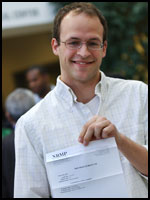Medical students find out their residency match during March Match Day tradition
 SYRACUSE, N.Y. — At noon today (March 18) 140 fourth-year students from Upstate Medical University's College of Medicine joined graduating medical students from across the country in learning where they will spend their first year of training (or residency) in their chosen specialty.
SYRACUSE, N.Y. — At noon today (March 18) 140 fourth-year students from Upstate Medical University's College of Medicine joined graduating medical students from across the country in learning where they will spend their first year of training (or residency) in their chosen specialty.
This annual rite of passage, known as Match Day, was established in 1952 by the National Resident Matching Program (NRMP) of the Association of American Medical Colleges. The matching program provides an orderly and fair way to match the preferences of applicants for U.S. residency positions with the residency program's choice of applicants. It also provides a common time for the announcement of the appointments, as well as an agreement for programs and applicants to honor the commitment to offer and accept an appointment if a match results.
At SUNY Upstate Medical University:
• 59 fourth-year medical students will enter the primary care specialties comprised of: internal medicine (32 students), pediatrics (10 students), family medicine (11 students), medicine/pediatrics (1 student), and obstetrics and gynecology (5 students);
• 77 students will remain in New York State;
• 4 students will complete their residencies in Canada;
• 24 first-year residents will remain in Syracuse: 18 residents at Upstate University Hospital and six residents at St. Joseph's Hospital Health Center.
In addition to matching its students to programs throughout the country, SUNY Upstate must also fill its own residency positions.
According to Sara Jo Grethlein, M.D., associate dean for SUNY Upstate's graduate medical education, SUNY Upstate has filled all of its 92 specialty and subspecialty residency positions.
"We are especially pleased to have retained 18 of our own students in residency positions at Upstate Medical University," said Grethlein. "This year's incoming class will be an excellent addition to our institution."
Since 1952, the NRMP has served as an initial indicator of the career interests of U.S. medical school graduates and other physicians who seek training in U.S. residency programs.
In the months prior to Match Day, students submit resumes and interview at hospitals. In February, both hospitals and students rank their choices for placement. The match process is conducted primarily through the Web—a computer center in Washington, D.C., the National Resident Matching Program—generates the matches.
-30-
